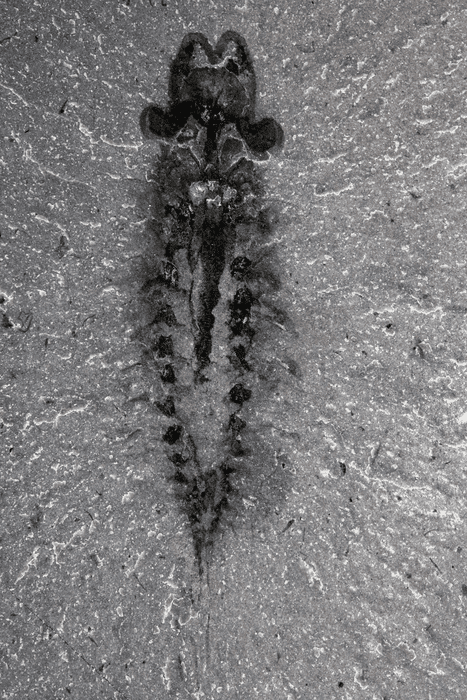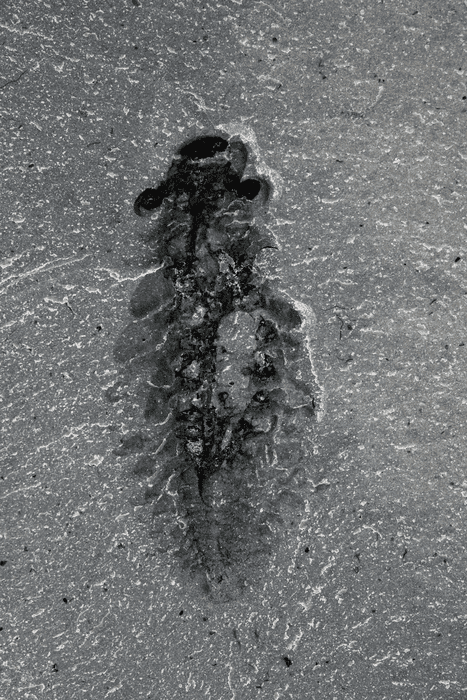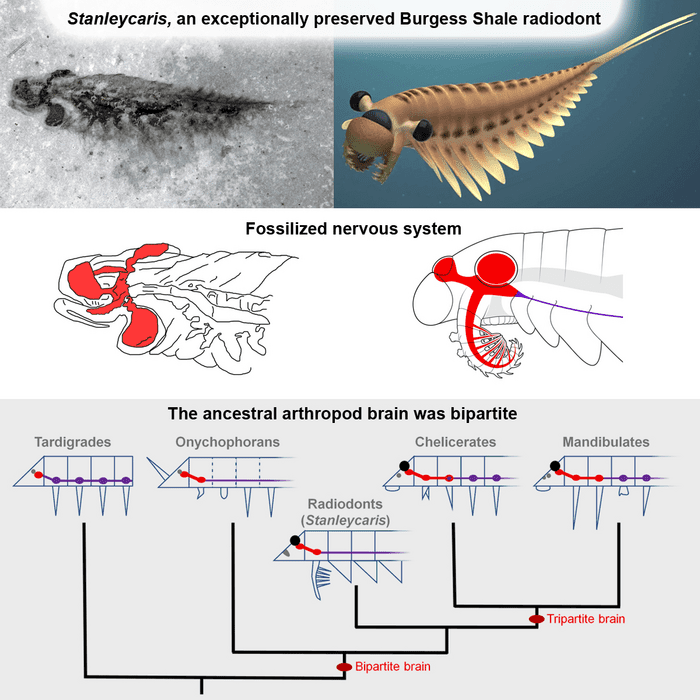The discovery of fossilized brains and nervous tissues of a distant ancestor of today’s insects and spiders is upending our understanding of this group’s evolutionary history.

Researchers at the Royal Ontario Museum (ROM) describe a new cache of fossils that contain an incredible morsel. The half-a-billion-year-old marine predator fossils contain excellently-preserved brains and nervous systems. The fossils belong to an ancient relative of the arthropods, a predator named Stanleycaris hirpex, a member of the Radiodonta family. As a distant relative of today’s insects and spiders, the discovery gives us a unique glimpse into the evolutionary history of their brains, vision, and head structure.
Old brains
“While fossilized brains from the Cambrian Period aren’t new, this discovery stands out for the astonishing quality of preservation and the large number of specimens,” said Joseph Moysiuk, lead author of the research and a University of Toronto (U of T) PhD Candidate in Ecology and Evolutionary Biology, based at the Royal Ontario Museum. “We can even make out fine details such as visual processing centers serving the large eyes and traces of nerves entering the appendages. The details are so clear it’s as if we were looking at an animal that died yesterday”.

The research is based on a previously-unpublished collection of 268 specimens of Staleycaris collected in the 1980s and 90s from rocks in the famous Walcott Quarry site of the Burgess Shale in Yoho National Park, B.C., since housed at ROM. In 84 of these specimens, the remains of the brain and nerves are well-preserved, the team explains. Based on the study of these specimens, the team reports that the animal’s brain was composed of two segments: a protocerebrum and deutocerebrum. These were connected to the eyes and frontal claws, respectively.
Today’s arthropods have three-segmented brains, consisting of the protocerebrum, deutocerebrum, and tritocerebrum. The team says that the two-segmented structure of Stanleycaris’s head and brain likely represents a stepping stone towards this final structure.
Although the differences between 2 lobes and 3 lobes might not sound important, the authors explain that it has some very meaningful implications. Arthropods have repeated copies of many of their organs throughout their segmented bodies, and understanding how different species handle this segmentation is an important step toward understanding the evolutionary history of the group.
“These fossils are like a Rosetta Stone, helping to link traits in radiodonts and other early fossil arthropods with their counterparts in surviving groups,” Moysiuk adds.
Another surprising find was that Stanleycaris possessed a large eye at the front of its head alongside its pair of stalked eyes. This feature has never been seen in a radiodont before. According to Dr. Jean-Bernard Caron, ROM’s Richard Ivey Curator of Invertebrate Palaeontology, and Moysiuk’s PhD supervisor, “[The feature] emphasizes that these animals were even more bizarre-looking than we thought”. It also showcases the huge variety of shapes and organ configurations that ancient life experimented with, especially in the case of early arthropods and their visual systems compared to their relatives of today.

The discovery is particularly important as most radiodonts known today were described only from incomplete specimens. As such, the current fossils help us better understand exactly what these animals looked like and how they lived.
During the Cambrian Period, a window of geological time known for its immense diversity of life and the strange shapes it would take, radiodonts numbered among the largest animals on the planet. One of them, Anomalocaris, reached over 1 meter in length — at a time when most animals grew about as large as a human finger. At around 20 cm in length, Stanleycaris was relatively small for the family it belonged to, but was still a fierce predator in its own right.
Stanleycaris was armed with a fearsome circular, tooth-lined mouth, frontal claws, an impressive array of spines, and several swimming flaps lining its segmented body. This impressive panoply of weapons was supported by its sophisticated sensory organs and nervous system. This combination likely made it a very capable hunter, able to detect even small prey in low-light conditions and snatch up anything it came across.
Apart from the results of this paper, the fossils go to show just why the Burgess Shale is considered to be such a valuable resource for paleontologists, and why it was designated a UNESCO World Heritage Site in 1980 and is now part of the larger Canadian Rocky Mountain Parks World Heritage Site. The sheer wealth of fossils discovered in this formation is outstanding, and the Stanleycaris specimens only add to an exceptionally long list of fossils recovered from here.
The paper “A three-eyed radiodont with fossilized neuroanatomy informs the origin of the arthropod head and segmentation” has been published in the journal Current Biology.









